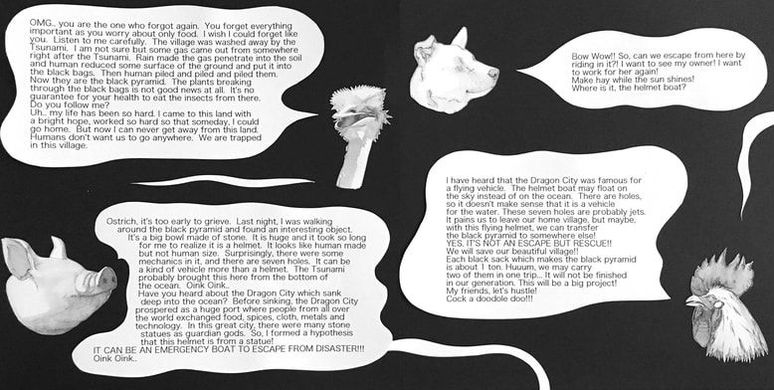Village of Oblivion, 2016
Kiosk of Oblivion is a sculpture in the shape of a park kiosk, with drawings that would refer to what was going on in Japan. The kiosk consists of a wooden structure, a complicated drawn map covered with Plexiglass, and leaflets that viewers can take away. This strange kiosk is meant to seem as if it is rising from the ground, as represented by a “hole” on the floor that has the same shape as the kiosk’s roof. In the map and leaflet, seven domestic animals who were left in Fukushima right after the nuclear power plant meltdown—Dog, Cat, Cow, Pig, Hen, Rooster, and Ostrich—are showing the world of their disaster. They are discussing the condition of their polluted land, and also the discovery of a mysterious boat shaped like a helmet near the so-called Black Pyramids, which actually exists in Fukushima. These are piles of black plastic bags into which irradiated soil was scraped in order to be contained. The helmet-like boat, which is my own invention, seemed to the animals to have come from the bottom of the ocean, because it appeared after the tsunami. Pig has a hypothesis that the boat is from the Dragon City, which is a legendary city that sank into the bottom of the ocean long ago. The animals began to have hope of using the boat to escape from the polluted land.
With this project, I began to develop the idea of working with animal protagonists as universal figures that do not represent any race or nationality. I depict them as creatures without eyes and sometimes without legs or bodies. In fact, my idea of protagonists without eyes began in 2007 when I was drawing satirically about my own experience right after I moved to the U.S. The woman without eyes was myself—a woman who couldn’t act the right way in a foreign country. It also reflects the sense of non-identity in Japanese society. Now, with the animals without eyes making their way through an apocalyptic world, the meaning of the missing part of the body turns into a more specific meaning: that of the sense of failure and regret to humanity’s technological development. The blind animals constitute small societies within the violent world which I reflect in my art mixing Japan, where I grew up, and the U.S., where I have been living for 11 years. They are enacting the struggles and embodying the emotions of anxiety, anger, sadness, sarcastic, tragic, abandonment, and hope.
Kiosk of Oblivion
Kiosk of Oblivion is a sculpture in the shape of a park kiosk, with drawings that would refer to what was going on in Japan. The kiosk consists of a wooden structure, a complicated drawn map covered with Plexiglass, and leaflets that viewers can take away. This strange kiosk is meant to seem as if it is rising from the ground, as represented by a “hole” on the floor that has the same shape as the kiosk’s roof. In the map and leaflet, seven domestic animals who were left in Fukushima right after the nuclear power plant meltdown—Dog, Cat, Cow, Pig, Hen, Rooster, and Ostrich—are showing the world of their disaster. They are discussing the condition of their polluted land, and also the discovery of a mysterious boat shaped like a helmet near the so-called Black Pyramids, which actually exists in Fukushima. These are piles of black plastic bags into which irradiated soil was scraped in order to be contained. The helmet-like boat, which is my own invention, seemed to the animals to have come from the bottom of the ocean, because it appeared after the tsunami. Pig has a hypothesis that the boat is from the Dragon City, which is a legendary city that sank into the bottom of the ocean long ago. The animals began to have hope of using the boat to escape from the polluted land.
With this project, I began to develop the idea of working with animal protagonists as universal figures that do not represent any race or nationality. I depict them as creatures without eyes and sometimes without legs or bodies. In fact, my idea of protagonists without eyes began in 2007 when I was drawing satirically about my own experience right after I moved to the U.S. The woman without eyes was myself—a woman who couldn’t act the right way in a foreign country. It also reflects the sense of non-identity in Japanese society. Now, with the animals without eyes making their way through an apocalyptic world, the meaning of the missing part of the body turns into a more specific meaning: that of the sense of failure and regret to humanity’s technological development. The blind animals constitute small societies within the violent world which I reflect in my art mixing Japan, where I grew up, and the U.S., where I have been living for 11 years. They are enacting the struggles and embodying the emotions of anxiety, anger, sadness, sarcastic, tragic, abandonment, and hope.
Kiosk of Oblivion
© 2015 Gaku Tsutaja
